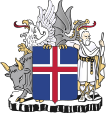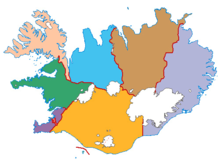| Revision as of 23:44, 6 April 2020 editMelvindillinger (talk | contribs)Extended confirmed users6,573 edits →Overview: I updated the Populations.Tags: Mobile edit Mobile web edit Advanced mobile edit← Previous edit |
Latest revision as of 03:14, 4 January 2025 edit undoHtialilwW (talk | contribs)334 editsNo edit summaryTags: Mobile edit Mobile web edit |
| (30 intermediate revisions by 16 users not shown) |
| Line 1: |
Line 1: |
|
|
{{Short description|Administrative divisions of Iceland}} |
|
{{Refimprove|date=January 2017}} |
|
|
{{Politics of Iceland}} |
|
{{Politics of Iceland}} |
|
|
The '''regions of ]''' are eight areas of Iceland that roughly follow the arrangement of ] as they were between 1959 and 2003. These regions are not incorporated ] but rather recognized groupings of municipalities. Iceland only has two levels of administration, the national government and 62 ]. The municipalities have organized themselves into eight regional associations<ref>{{cite web |title=Landshlutasamtök |url=https://www.samband.is/sveitarfelogin/#tab4 |publisher=Icelandic Association of Local Authorities |access-date=10 June 2021}}</ref> and those boundaries are also recognized by ] to report statistics.<ref>{{cite web |title=Iceland in figures 2018 |date=12 June 2018 |url=https://issuu.com/hagstofa/docs/iceland_in_figures_2018 |publisher=Statistics Iceland |access-date=10 June 2021}}</ref> Since 2014, ] and commissioner ('']'') districts have followed the eight region model with the exception that ] form a special district and are not part of the South region. The divisions of Iceland for the purposes of health care and district courts diverge more from the commonly used eight region model. |
|
The '''regions of ]''' are mainly used for statistical purposes. The district court jurisdictions also follow these divisions. The ] system follows the regions as well, with a few exceptions. Prior to 2003, the regions were also used as overall constituencies in certain ]. Excluding its usage in collecting national statistics, particularly census data, these definitions rely upon the discontinued ] capital proper.{{clarify|date=April 2019}} |
|
|
|
|
|
|
|
The ] system also roughly corresponds with the regions with the first digit of the three digit codes usually being the same as on the map below. |
|
In addition, the borders of the previous ] region, as defined by the government and regional authorities, have shifted, resulting in the loss of many municipalities to the newly formed ] area. Other major changes have also been included, such as the redistribution of over twenty subdivisions, most notably the transfer of the city of ] to the ]. |
|
|
|
|
|
These regions are not defined by law and have no official standing or administrative function, but are used to divide Iceland for certain purposes. The country's ] program is divided into seven districts. These regions mostly correspond to those detailed below, although a few updates have yet to be fully implemented. For example, settlements in the ] have suffered minor effects from the merger of the Northwest and Northeast into a single group. |
|
|
|
|
|
|
==Overview== |
|
==Overview== |
|
] |
|
] |
|
⚫ |
{| class="wikitable sortable" style="text-align: right;” |
|
|
|
|
|
|- |
| ⚫ |
{|class="sortable wikitable" style="text-align: right;" |
|
|
!No. |
|
!No. |
|
!English name |
|
!English name |
|
!Native name |
|
!Native name |
|
|
!Population |
|
!Population(2020)<ref></ref> |
|
(2024)<ref></ref> |
|
!Area(km²) |
|
!Area (km<sup>2</sup>) |
|
!style="width: 8.5em;" | Population density (per km²) |
|
!style="width: 8.5em;" | Population density (per km<sup>2</sup>) |
|
!] |
|
!] |
|
|
!style="width: 7.0em;" | Number of municipalities |
|
!Seat |
|
|
|
!style="width: 7.0em;" | Largest town |
|
|- |
|
|- |
|
|1 |
|
|1 |
|
|style="text-align: left;"|] |
|
|style="text-align: left;"|] |
|
|style="text-align: left;"|Höfuðborgarsvæðið |
|
|style="text-align: left;"|Höfuðborgarsvæðið |
|
|233,034 |
|
|244,177 |
|
|1,062 |
|
|1,046 |
|
|214.91 |
|
|233.44 |
|
|IS-1 |
|
|IS-1 |
|
|
|7 |
|
|style="text-align: left;"|] |
|
|style="text-align: left;"|] |
|
|- |
|
|- |
| Line 32: |
Line 33: |
|
|style="text-align: left;"|] |
|
|style="text-align: left;"|] |
|
|style="text-align: left;"|Suðurnes |
|
|style="text-align: left;"|Suðurnes |
|
|27,829 |
|
|30,933 |
|
|829 |
|
|813 |
|
|32.71 |
|
|38.05 |
|
|IS-2 |
|
|IS-2 |
|
|
|4 |
| ⚫ |
|style="text-align: left;"|] |
|
|
|
|style="text-align: left;"|] |
|
|- |
|
|- |
|
|3 |
|
|3 |
|
|style="text-align: left;"|] |
|
|style="text-align: left;"|] |
|
|style="text-align: left;"|Vesturland |
|
|style="text-align: left;"|Vesturland |
|
|16,662 |
|
|17,419 |
|
|9,554 |
|
|9,527 |
|
|1.73 |
|
|1.83 |
|
|IS-3 |
|
|IS-3 |
|
|
|9 |
| ⚫ |
|style="text-align: left;"|] |
|
|
⚫ |
|style="text-align: left;"|] |
|
|- |
|
|- |
|
|4 |
|
|4 |
|
|style="text-align: left;"|] |
|
|style="text-align: left;"|] |
|
|style="text-align: left;"|Vestfirðir |
|
|style="text-align: left;"|Vestfirðir |
|
|7,115 |
|
|7,168 |
|
|9,409 |
|
|8,842 |
|
|0.75 |
|
|0.81 |
|
|IS-4 |
|
|IS-4 |
|
|
|8 |
|
|style="text-align: left;"|] |
|
|style="text-align: left;"|] |
|
|- |
|
|- |
| Line 59: |
Line 63: |
|
|style="text-align: left;"|] |
|
|style="text-align: left;"|] |
|
|style="text-align: left;"|Norðurland vestra |
|
|style="text-align: left;"|Norðurland vestra |
|
|7,322 |
|
|7,294 |
|
|12,737 |
|
|13,108 |
|
|0.57 |
|
|0.56 |
|
|IS-5 |
|
|IS-5 |
|
|
|4 |
|
|style="text-align: left;"|] |
|
|style="text-align: left;"|] |
|
|- |
|
|- |
| Line 68: |
Line 73: |
|
|style="text-align: left;"|] |
|
|style="text-align: left;"|] |
|
|style="text-align: left;"|Norðurland eystra |
|
|style="text-align: left;"|Norðurland eystra |
|
|30,600 |
|
|31,574 |
|
|21,968 |
|
|22,677 |
|
|1.39 |
|
|1.39 |
|
|IS-6 |
|
|IS-6 |
|
|
|11 |
|
|style="text-align: left;"|] |
|
|style="text-align: left;"|] |
|
|- |
|
|- |
| Line 77: |
Line 83: |
|
|style="text-align: left;"|] |
|
|style="text-align: left;"|] |
|
|style="text-align: left;"|Austurland |
|
|style="text-align: left;"|Austurland |
|
|13,173 |
|
|11,085 |
|
|22,721 |
|
|15,706 |
|
|0.57 |
|
|0.71 |
|
|IS-7 |
|
|IS-7 |
|
|
|4 |
|
|style="text-align: left;"|] |
|
|style="text-align: left;"|] |
|
|- |
|
|- |
| Line 86: |
Line 93: |
|
|style="text-align: left;"|] |
|
|style="text-align: left;"|] |
|
|style="text-align: left;"|Suðurland |
|
|style="text-align: left;"|Suðurland |
|
|28,399 |
|
|34,076 |
|
|24,526 |
|
|30,983 |
|
|1.11 |
|
|1.10 |
|
|IS-8 |
|
|IS-8 |
|
|
|15 |
|
|style="text-align: left;"|] |
|
|style="text-align: left;"|] |
|
|- |
|
|- |
| Line 95: |
Line 103: |
|
!style="text-align: left;" |Iceland |
|
!style="text-align: left;" |Iceland |
|
!style="text-align: left;" |Ísland |
|
!style="text-align: left;" |Ísland |
|
!style="text-align: right;"|364,134 |
|
!style="text-align: right;"|383,726 |
|
!style="text-align: right;"|102,806 |
|
!style="text-align: right;"|102,702 |
|
!style="text-align: right;"|3.47 |
|
!style="text-align: right;"|3.74 |
|
!style="text-align: right;"|IS |
|
!style="text-align: right;"|IS |
|
|
!style="text-align: right;"|62 |
|
! |
|
|
|
!style="text-align: right;"|Reykjavík |
|
|} |
|
|} |
|
|
|
|
|
==Differences from the 1959-2003 constituencies== |
|
|
] |
|
|
Until 1957, the parliamentary constituencies used in Iceland had been based on its ] and ]. The reform of constituency borders in 1957 would group these counties and towns together into eight larger areas that form the basis for the modern regional division of Iceland. The differences between the 1957 boundaries and the modern ones are: |
|
|
* The southwestern part of the country was previously divided into Reykjavík on one hand and Reykjanes on the other which encompassed all other municipalities in the vicinity of Reykjavík and on the ]. The same area is currently divided into the Capital region on one hand and the ] on the other |
|
|
* The ] decided in 2008 to leave the association for municipalities in the Eastern region and join the Southern region.<ref>{{cite news |title=Hornfirðingar vilja samstarf með Sunnlendingum |url=https://www.mbl.is/greinasafn/grein/1212654/ |access-date=10 June 2021 |publisher=Morgunblaðið |date=8 May 2008 |language=Icelandic}}</ref> ] updated its definition of the statistical regions to reflect this on 1 December 2020.<ref>{{cite web |title=Landsmönnum fjölgaði um 1,3% á milli ára |url=https://hagstofa.is/utgafur/frettasafn/mannfjoldi/mannfjoldinn-1-januar-2021/ |publisher=Statistics Iceland |access-date=10 June 2021 |language=Icelandic |date=22 March 2021}}</ref> |
|
|
* The area of the former town of ] was transferred from the Northwestern region to the Northeastern region when the town merged across the regional boundary with ] to form ] in 2006. |
|
|
* The area of the former municipality of ] was transferred from the Eastern region to the Northeastern region when the municipality merged across the regional boundary with ] to form ] in 2006. |
|
|
* The area of the former municipality of ] was transferred from the Westfjords region to the Northwestern region when the municipality merged across the regional boundary with ] under the name of the latter in 2012. |
|
|
|
|
|
|
|
|
==See also== |
|
==See also== |
|
|
*] |
|
*] |
|
*] |
|
*] |
|
*] |
| Line 118: |
Line 138: |
|
] |
|
] |
|
] |
|
] |
|
] |
|
] |
|
] |
|
] |
|
] |
|
] |
Until 1957, the parliamentary constituencies used in Iceland had been based on its counties and market towns. The reform of constituency borders in 1957 would group these counties and towns together into eight larger areas that form the basis for the modern regional division of Iceland. The differences between the 1957 boundaries and the modern ones are:



